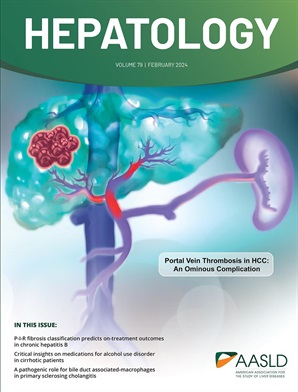MARCO+肿瘤相关巨噬细胞和CTSE+肿瘤细胞的共定位决定了肝内胆管癌的不良预后
IF 12.9
1区 医学
Q1 GASTROENTEROLOGY & HEPATOLOGY
引用次数: 0
摘要
瘤内免疫浸润是肝内胆管癌(ICC)中与肿瘤细胞相互作用的关键因素。然而,其表型和相关的空间结构仍然难以捉摸。为了解决这些局限性,我们结合空间数据(来自 6 个样本的 29,632 个点)和单细胞数据(来自 35 个样本的 21,158 个细胞)进行了一项综合研究。我们确定了两种不同的浸润模式:巨噬细胞+(以 CD68 和 MARCO 为特征)和浆细胞+(以 IGHG1 和 JCHAIN 为特征)。巨噬细胞+和浆细胞+特征在ICC患者的生存中分别显示出不利和有利的作用。值得注意的是,在巨噬细胞+样本中,MARCO+肿瘤相关巨噬细胞(TAM)被认为是主要的细胞类型,表明存在免疫抗性微环境。在 MARCO+ TAM 中观察到上皮-间质转化活性、血管生成和缺氧增加。在空间转录组学和大容量转录组学数据中观察到 MARCO+ TAM 和 CTSE+ 肿瘤细胞共定位,并通过对 20 个 ICC 样本进行多重免疫荧光验证。共定位区域表现出相似的原发肿瘤途径和抑制性免疫反应。CTSE 表现出与肝内转移和血管侵袭相关。MARCO+ TAM和CTSE+肿瘤细胞都与生存率降低有关,两种细胞类型高度浸润的患者生存率最差。在共定位区域内,galectin 信号通路在细胞-细胞通讯中最为活跃,LGALS9-CD44 被确定为主要的配体-受体对。这项研究发现,巨噬细胞+和浆细胞+的肿瘤内免疫浸润模式以及MARCO+ TAM和CTSE+肿瘤细胞的共定位是导致免疫抵抗的因素。本文章由计算机程序翻译,如有差异,请以英文原文为准。
The co-location of MARCO+ tumor-associated macrophages and CTSE+ tumor cells determined the poor prognosis in intrahepatic cholangiocarcinoma
Intra-tumor immune infiltration is a crucial element interacting with tumor cells in intrahepatic cholangiocarcinoma (ICC). However, its phenotype and related spatial structure remained elusive. To address these limitations, we undertook a comprehensive study combining spatial data (29,632 spots from six samples) and single-cell data (21,158 cells from 35 samples). We identified two distinct infiltration patterns: macrophage+ (characterized by CD68 and MARCO) and plasma cell+ (characterized by IGHG1 and JCHAIN). The macrophage+ and plasma cell+ signatures showed adverse and favorable roles in ICC patients’ survival, respectively. Notably, MARCO+ tumor-associated macrophage (TAM) was recognized as the main cell type in macrophage+ samples, indicating an immune-resistant microenvironment. Increased epithelial-mesenchymal transition activities, angiogenesis, and hypoxia were observed in MARCO+ TAM. The co-location of MARCO+ TAM and CTSE+ tumor cells was observed in spatial transcriptomics and bulk transcriptomics data, validated by multiplex immunofluorescence performed on twenty ICC samples. The co-location area exhibited similar protumorigenic pathways and suppressed immune response. CTSE exhibited associations with intrahepatic metastasis and vascular invasion. Both MARCO+ TAM and CTSE+ tumor cells were associated with worse survival and patients with high infiltration of two cell types displayed the worst survival. Within the co-location area, the galectin signaling pathway was most active in cell-cell communication, with LGALS9-CD44 identified as the main ligand-receptor pair. This study identified macrophage+ and plasma cell+ intra-tumor immune infiltration patterns and the co-location of MARCO+ TAM and CTSE+ tumor cells as contributors to immune resistance.
求助全文
通过发布文献求助,成功后即可免费获取论文全文。
去求助
来源期刊

Hepatology
医学-胃肠肝病学
CiteScore
27.50
自引率
3.70%
发文量
609
审稿时长
1 months
期刊介绍:
HEPATOLOGY is recognized as the leading publication in the field of liver disease. It features original, peer-reviewed articles covering various aspects of liver structure, function, and disease. The journal's distinguished Editorial Board carefully selects the best articles each month, focusing on topics including immunology, chronic hepatitis, viral hepatitis, cirrhosis, genetic and metabolic liver diseases, liver cancer, and drug metabolism.
 求助内容:
求助内容: 应助结果提醒方式:
应助结果提醒方式:


